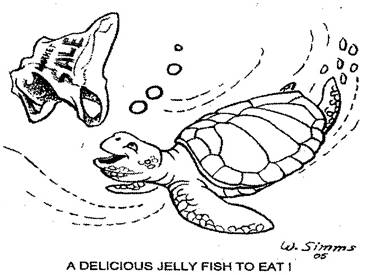Appeared in Vall-E-Vents, the San Fernanado Valley Sierra Club Newsletter, July 2005.
Plastics for Dinner
(#2 of the Plastics Plague series)
by Sarah S. Mosko, Ph.D.

Most litter eventually finds it way to the ocean. Illustration by Willis Simms.
Most litter eventually finds it way to the ocean. Plastics bags are swept in by winds, while heavier trash washes in via rainstorm run-off. Dumping at sea and cargo spills account for only 20% of trash in our oceans, with 80% from land-based sources.
Just about everything today is made from plastic it seems. Since plastics do not biodegrade, but rather break into smaller plastic fragments, our oceans are awash with plastic debris. Nearly 90% of ocean debris is in fact plastic. There are even areas of ocean where plastic fragments outweigh zooplankton by a factor of six to one. Unfortunately, sea creatures are not equipped to discriminate plastics from their normal diet. The consequences are devastating.
A plastic bag floating in water probably looks a lot like a jellyfish to a hungry sea turtle. Hard plastic fragments resemble krill, small shrimp-like crustaceans favored by many sea animals. Read the rest of this entry »



 Posted by Sarah (Steve) Mosko
Posted by Sarah (Steve) Mosko